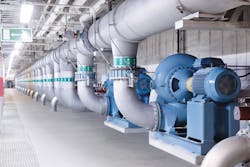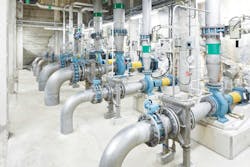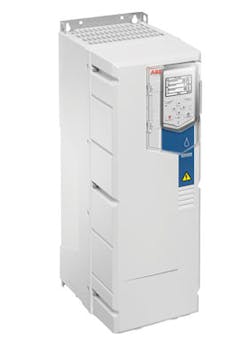By Jukka Tolvanen
Using variable speed drives (VSDs) in the water industry is one of the most effective ways to save energy. While other energy-saving methods may shave singular percentage points off the overall consumption, a VSD can often save 30 percent or more of the energy in water and wastewater applications such as pumps and fans.
Electric motors use two-thirds of all electricity in the industry, so any efforts to reduce this load, even by single figures, is highly significant. The opportunity to cut energy consumption by up to half ought to peak industry interest. Yet, VSDs are only installed in a minority of applications. The reasons often boil down to a disconnect between those who design these applications and those responsible for the energy bill. Even then, those paying the bill are often not engineers and are not aware of the benefits VSDs can offer.
Speed vs. Energy Requirement
Water-dedicated variable speed drives reduce the output of a water application component, such as a pump, by controlling the speed of the motor, ensuring that it runs no faster than it needs to. When other control methods are used, the motor runs at full speed and the flow of the output is throttled, by a valve for example. This is wasteful because the motor keeps running at its nominal speed regardless of the requirement. The pump delivers maximum output and the excess is reduced at the valve, where the surplus energy is wasted through friction.
The relationship between a pump’s speed and its energy requirement is known as the cube law because the need for power increases with the cube of the speed. This means that a small increase in pump speed requires a lot more power, but a modest speed reduction can result in significant energy savings. A pump running at half speed consumes only one-eighth of the power compared to one running at full speed.
The problem of energy waste is exacerbated by the fact that many motors are oversized, using more energy than the water application actually needs. This is because motors are only available with a certain number of fixed speeds. Users tend to fit the next bigger size relative to the requirement and then throttle the output.
Normally, electric motors only have one speed; if you want a different speed, you must buy a different motor. Variable speed drives work by controlling the waveform of the current and voltage supplying the motor. The movement of the motor shaft can be adjusted with great accuracy, which ensures that the water application gives the performance needed.
Lowering Life Cycle Costs
Some users still favor traditional control methods within the water industry because they feel that these methods are easy to implement and straightforward to understand.
However, many water utility managers and operators could potentially save a significant amount of money in annual electricity costs by using water-dedicated variable speed drives. One might assume that the cost of the wasted energy is less than that of buying a VSD. However, unlike many other energy-saving methods that may only reduce energy consumption by one or two percent, the significant savings produced by a VSD means payback is often achieved in a year or less. The application will then continue to make a significant contribution to energy savings, year after year, for as long as it remains in use.
Case Study: Fiskeby Board
Fiskeby Board AB in Sweden is Scandinavia’s only white-lined chipboard producer. Using 100 percent recycled fiber, Fiskeby makes what is considered to be Europe’s strongest recycled paperboard. The mill is also the only one in Scandinavia that can recycle composite liquid packaging board (LPB) such as used in milk and juice cartons.
Fiskeby is a major user of energy, and at the same time very conscious about energy conservation. ABB’s industrial drive, the wall-mounted ACS880-01, was installed on a dilution water pump resulting in an immediate 80 percent reduction in the energy needed for that operation. Each year this amounts to around 120 MWh and approximately 7,000 euros, which translates into a payback time of less than two years. More of these drives have since been installed, with excellent results.
Only Running at the Speed Required
Previous to the installation of the drive, flow control was achieved by running the pump full speed against a valve that was nearly closed 80 percent of the time. This was like driving a car and pushing both the accelerator and the brake at the same time. It was an outdated control system, typical of applications with large potential for energy savings. With the drive, the pump now runs at a speed depending on the level of the tank it is feeding. This means it is running slower for much of the time, hence the energy savings.
Where to Start
In order for a water company to reduce energy costs, it is a good idea to first evaluate how energy is being used. An energy appraisal is a systematic examination of key pump applications. It helps define where and how much energy could be saved with the installation of VSDs. Seeing the potential savings in black and white can help operators to make informed decisions that ultimately deliver improved profitability.
About the Author: Jukka Tolvanen is a program manager responsible for energy-efficiency-related R&D programs at ABB Drives. He holds a master’s degree in electrical engineering from the University of Technology in Helsinki, Finland.





